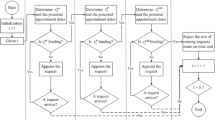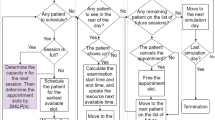Abstract
This study is concerned with the problem of reducing the waiting times of outpatients. Both scheduled patients and walk-ins are included among the outpatients to reflect the typical medical environment in Japan. The consultation time of a hospital is divided into several blocks, and each scheduled patient is given the start time of a block as his or her scheduled time of the consultation as an appointment. It is assumed that all scheduled patients arrive at the hospital at their scheduled times, while walk-ins arrive randomly. A set of candidate appointment schedules is given, and the process of selecting promising schedules in terms of average waiting times is the focus of the work. To support the selection process without conducting a conventional simulation, the notion of a clearing function is adopted to evaluate each candidate schedule. The clearing function of a system gives the expected output or throughput of the system under varying levels of workload of the system. Although it is necessary to conduct exploratory experiments in advance to obtain the clearing function, the expected waiting time can be estimated by simple calculations with the aid of the clearing function. The average waiting times of four schedules in two scenarios are calculated and compared with those obtained from conventional simulations. It is revealed that the proposed procedure based on the clearing function gives acceptable estimated average values.









Similar content being viewed by others
References
Alrefaei, M. H., & Andradóttir, S. (1999). A simulated annealing algorithm with constant temperature for discrete stochastic optimization. Management Science, 45(5), 748–764.
Asmundsson, J., Rardin, R. L., Turkseven, C. H., & Uzsoy, R. (2009). Production planning with resources subject to congestion. Naval Research Logistics, 56(2), 142–157.
Cayirli, T., & Veral, E. (2003). Outpatient scheduling in health care: A review of literature. Production and Operations Management, 12(4), 519–549.
Cayirli, T., & Yang, K. K. (2014). A universal appointment rule with patient classification for service times, no-shows, and walk-ins. Service Science, 6(4), 274–295.
Chen, R. R., & Robinson, L. W. (2014). Sequencing and scheduling appointments with potential call-in patients. Production and Operations Management, 23(9), 1522–1538.
Duffy, V. G. (2011). Improving efficiencies and patient safety in healthcare through human factors and ergonomics. Journal of Intelligent Manufacturing, 22(1), 57–64.
Feldman, J., Liu, N., Topaloglu, H., & Ziya, S. (2014). Appointment scheduling under patient preference and no-show behavior. Operations Research, 62(4), 794–811.
Gholami, M., & Zandieh, M. (2009). Integrating simulation and genetic algorithm to schedule a dynamic flexible job shop. Journal of Intelligent Manufacturing, 20(4), 481–498.
Green, L. V., & Savin, S. (2008). Reducing delays for medical appointments: A queueing approach. Operations Research, 56(6), 1526–1538.
Green, L. V., Savin, S., & Wang, B. (2006). Managing patient service in a diagnostic medical facility. Operations Research, 54(1), 11–25.
Gupta, D., & Denton, B. (2008). Appointment scheduling in health care: Challenges and opportunities. IIE Transactions, 40(9), 800–819.
Harper, P. R., & Gamlin, H. M. (2003). Reduced outpatient waiting times with improved appointment scheduling: A simulation modelling approach. OR Spectrum, 25(2), 207–222.
Hassin, R., & Mendel, S. (2008). Scheduling arrivals to queues: A single-server model with no-shows. Management Science, 54(3), 565–572.
Ho, C.-J., & Lau, H.-S. (1992). Minimizing total cost in scheduling outpatient appointments. Management Science, 38(12), 1750–1764.
Kaandorp, G. C., & Koole, G. (2007). Optimal outpatient appointment scheduling. Health Care Management Science, 10(3), 217–229.
Karmarkar, U. S. (1993). Manufacturing lead times, order release and capacity loading. In S. C. Graves, et al. (Eds.) Logistics of production and inventory. Handbooks in operations research and management science (vol. 4, Chapter 6, pp. 287–329). The Netherlands: Elsevier.
LaGanga, L. R., & Lawrence, S. R. (2007). Clinic overbooking to improve patient access and increase provider productivity. Decision Sciences, 38(2), 251–276.
Lin, J., Muthuraman, K., & Lawley, M. (2011). Optimal and approximate algorithms for sequential clinical scheduling with no-shows. IIE Transactions on Healthcare Systems Engineering, 1(1), 20–36.
Liu, N., Ziya, S., & Kulkarni, V. G. (2010). Dynamic scheduling of outpatient appointments under patient no-shows and cancellations. Manufacturing & Service Operations Management, 12(2), 347–364.
Missbauer, H., & Uzsoy, R. (2011). Optimization models of production planning problems. In K. G. Kempf, et al. (Eds). Planning production and inventories in the extended enterprise, international series in operations research & management science (vol. 151, pp. 437–507). Berlin: Springer.
Morikawa, K., Takahashi, K., & Hirotani, D. (2013). Outpatient sequencing with consideration of the average waiting times. Journal of Japan Industrial Management Association, 64(2), 119–127. (in Japanese).
Morikawa, K., Takahashi, K., & Hirotani, D. (2014). Make-to-stock policies for a multistage serial system under a make-to-order production environment. International Journal of Production Economics, 147(Part A), 30–37.
Murray, M., & Tantau, C. (2000). Same-day appointments: Exploding the access paradigm. Family Practice Management, 7(8), 45–50.
Muthuraman, K., & Lawley, M. (2008). A stochastic overbooking model for outpatient clinical scheduling with no-shows. IIE Transactions, 40(9), 820–837.
Nelson, B. L. (2010). Optimization via simulation over discrete decision variables. In Tutorials in operations research, INFORMS (pp. 193–207).
Pahl, J., Voß, S., & Woodruff, D. L. (2007). Production planning with load dependent lead times: An update of research. Annals of Operations Research, 153(1), 297–345.
Patrick, J., Puterman, M. L., & Queyranne, M. (2008). Dynamic multipriority patient scheduling for a diagnostic resource. Operations Research, 56(6), 1507–1525.
Reid, P. P., Compton, W. D., Grossman, J. H., & Fanjiang, G. (Eds.). (2005). Building a better delivery system: A new engineering/health care partnership. Washington, DC: National Academies Press.
Robinson, L. W., & Chen, R. R. (2010). A comparison of traditional and open-access policies for appointment scheduling. Manufacturing & Service Operations Management, 12(2), 330–346.
Sickinger, S., & Kolisch, R. (2009). The performance of a generalized Bailey–Welch rule for outpatient appointment scheduling under inpatient and emergency demand. Health Care Management Science, 12(4), 408–419.
Wang, W.-Y., & Gupta, D. (2011). Adaptive appointment systems with patient preferences. Manufacturing & Service Operations Management, 13(3), 373–389.
Acknowledgments
This work was supported by JSPS KAKENHI Grant Number 26350426. The authors would like to thank the anonymous reviewers for their valuable comments and suggestions.
Author information
Authors and Affiliations
Corresponding author
Rights and permissions
About this article
Cite this article
Morikawa, K., Takahashi, K. & Hirotani, D. Performance evaluation of candidate appointment schedules using clearing functions. J Intell Manuf 29, 509–518 (2018). https://doi.org/10.1007/s10845-015-1134-5
Received:
Accepted:
Published:
Issue Date:
DOI: https://doi.org/10.1007/s10845-015-1134-5




